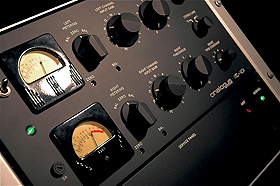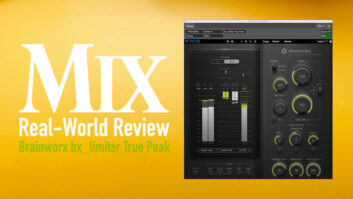
The AT-101 vastly improves upon the Fairchild 670’s inconsistent and unreliable operation.
The Fairchild 670 (and mono 660 version) were originally designed by Russian émigré Rein Narma for Les Paul in the 1950s for limiting audio program going to disc-cutting amplifiers. It’s considered by many to be the ultimate in audio limiters. This “holy grail” is found again and revised in Analoguetube’s AT-101 stereo limiter, a superaccurate re-creation that incorporates advances in component quality and carefully designed modern additions, yet retains the true essence and sound of the original Fairchild 670 limiter.
BIG AND BEAUTIFUL
The rackmount AT-101 is nearly eight spaces tall, with 20 tubes, four transformers per audio channel, five more transformers, and chokes in the power supply and control sections; it weighs 65 pounds. It is handmade with wiring turrets and point-to-point connections using silver-stranded wire to mil-spec construction (circa 1950), ceramic tube sockets, handmade high-voltage silver-mica condensers, Hovland Musicap polypropylene film capacitors and custom-made Sowter transformers.
To solve the Fairchild’s “Achilles’ heel,” Analoguetube commissioned JJ Electronics to remanufacture the long-out-of-production GE Five Star 6386 tubes—four matched sets are required per channel. The 6386 is a remote cut-off, twin-triode with exponential—as opposed to linear—transfer characteristics. These tubes ($120 each)—along with the transformers, power supply design and the high-voltage sidechain control signal—are the core reasons the Fair- child and now the AT-101 sound as they do and are free of ugly limiter/compressor artifacts, no matter how much compression is used.
Other modern remedies include a more efficient power supply that ramps up the filament voltage upon power-up for longer tube life; a regulated high-voltage B+ source; an additional regulated linear power supply for the 6386 tubes; an over-temperature monitoring system—the unit dissipates more than 300 watts in heat; and a stereo-link switch replacing the 670’s Lateral/Vertical M/S processing mode.
IN THE STUDIO
I’ve been using the AT-101 on every possible source, including across the stereo bus. The Fairchild 670 was the first limiter I ever used, and over the years I’ve experienced its inconsistent and unreliable operation, sonic differences between the channels, and the day-by-day changes in compression and distortion. By comparison, the AT-101 is smoother and more liquid sounding; warmer and richer without being boomy; and “shiny” sounding without treble hype.
After finding unity gain on the AT-101, I sent my Pro Tools mix out to the unit and returned its output back into my Benchmark Media ADC1 A/D converter for recording back into the DAW. My first mix was a country rock song. All of the typical complaints from the “in-the-box” mix naysayers vanished, as the overall mix instantly gelled with a rich and super-warm sheen. However, my first settings were too heavy-handed. After repeated listens, I began to miss the give and take of the track’s internal dynamics. After backing the threshold control down, I ended up with about 2dB maximum gain reduction on peaks as indicated on the unit’s two big VU meters. The mix was still smooth but not as clamped-sounding.
On a smooth jazz song mix, I used the Time Constant (TC) set to 2 with its 0.2 ms attack and 0.8-second release times. I got about 3dB max gain reduction with the threshold at 3. Threshold settings follow level input. If you turn up the level input, the output level goes up predicated on the threshold knob’s setting. At fully CCW (off), the AT-101 will make about 18 dB of super-warm gain.

The back panel of the AT-101 also sees a moden twist on the original 670.
I tried all six time-constant settings, and found positions 1 or 2 good for up-tempo songs, and positions 4 or 5, with their automatic program-dependent release times, better when you’re looking more to warm up the sound than to control it.
As I rarely place loud “meter-moving” mix elements hard-left and -right, I’ve never been a big fan of stereo linking. It works fine on the AT-101, but I didn’t use it for any of these tests.
I also didn’t use linking to record my 80-year-old Schiller baby grand piano. I used two Mojave 101 FET condenser mics (with -15dB pads) placed over the hammers. I used my RTZ 9762 mic preamp (a mil-spec version of the Neve 1272 circuit) plugged directly into the AT-101 followed by my ADC-1.
I used TC position 3 this time, and no matter how much you like to squash when recording, the sound was always smooth, bright (I used no EQ) and full. Winding up the input level control or just driving more level from the mic pre and/or increasing the threshold control gets you needle-pinning gain reduction—around 15 dB—that sounds fantastic.
The piano’s soundboard and resonance, string harmonics, and even my piano’s squeaky sostenuto pedal are all well heard, yet the attack of the hammers is somewhat rounded off—in spite of where I placed the mics. It’s easy to get all those cool piano sounds you know from The Beatles, Rolling Stones and Pink Floyd.
The longer release times of TC positions 5 and 6 will act as a kind of release time Hold button where gain reduction is “frozen” over short time periods of no sound. When sound resumes, the AT-101’s output level will be more or less the same as before. This is important when the user is relying on a compressor/limiter for a certain level of consistency when recording musical phrases separated by time gaps.
Recording and processing vocals in a mix are a lot of fun. There is no obsessing over exact record or mix levels when your singer gets (unexpectedly) louder or softer—the AT-101 makes it all good. I used TC position 3 or 4 and limited as much as the producer and I wanted. With my quiet preamp, we found no additional noise with the AT-101, making it possible to hear all the grit, grain and subtleties of our singer’s voice, the mic and the surrounding recording space.
FAIRCHILD REINCARNATED
The AT-101 is truly the ultimate limiter for any source and, as a mix bus limiter, it’s a dream come true. It’s the realization of the epitome of Narma’s original concept and design, and if there was ever an addictive piece of outboard gear, I have found it.
Barry Rudolph is an L.A.-based engineer.

Click on the Product Summary box above to view the AT-101 product page.







